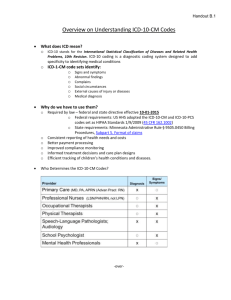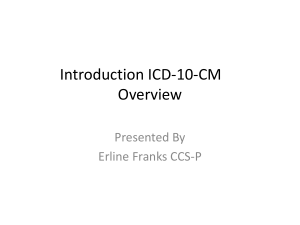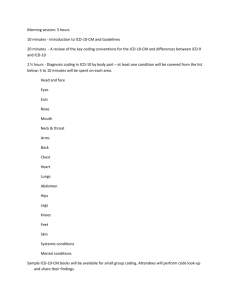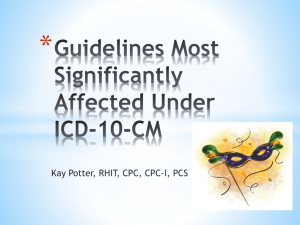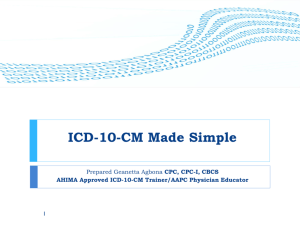ICD-10-CM IEP Mental Health. Final rel 05.20.2015 (1)
advertisement
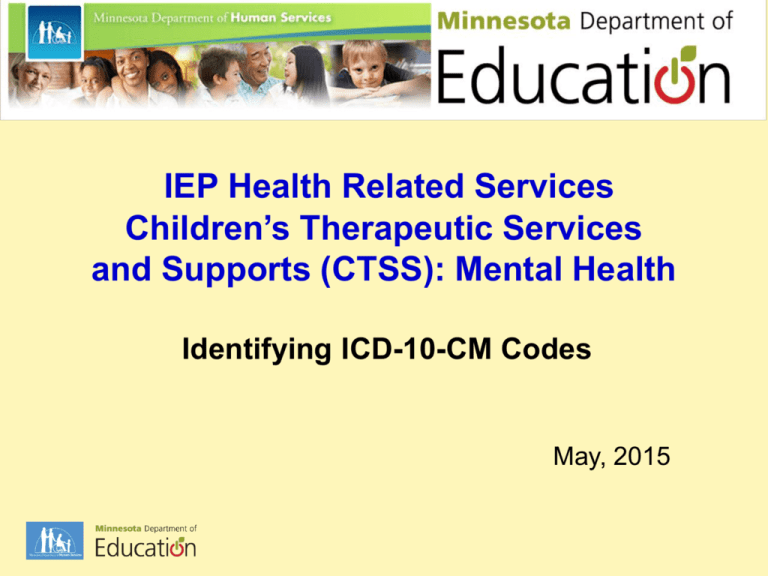
IEP Health Related Services Children’s Therapeutic Services and Supports (CTSS): Mental Health Identifying ICD-10-CM Codes May, 2015 What are the ICD-10-CM Codes Sets? The ICD-10-CM code sets identify: Signs and symptoms Abnormal findings Complaints Social circumstances External causes of injury or diseases Medical diagnoses 2 What Does this Mean for Schools? Schools must provide an ICD-10-CM code for each billable IEP health related service. These services include: Mental health (CTSS) Nursing Occupational therapy Physical therapy Speech-language pathology and audiology PCA Transportation Assistive Technology Interpreter Services 3 Who Determines the ICD-10-CM Codes? Diagnosis Signs/ Symptoms RN) x o (LSN/PHN/RN, not LPN) o x Occupational Therapists o x Physical Therapists o x Speech-Language Pathologists; Audiology School Psychologist x x o x Mental Health Professionals x o Provider Primary Care (MD, PA, APRN (Advan Pract Professional Nurses 4 Who Determines the ICD-10-CM Codes For Other IEP Health Related Services? The IEP health related service professional who is training, directing, supervising or ordering the service, selects the ICD-10-CM code(s) for: PCA services Special Transportation Assistive Technology Interpreter services In most cases it is the same ICD-10-CM code used by the professional. 5 Student Scenario The child has been diagnosed by a mental health professional as having Attention Deficit Hyperactivity Disorder (ADHD), DSM 5 code F90.0, identifying that the child is predominately inattentive presentation. The child has also has been diagnosed by their primary care provider as having asthma, ICD-10-CM code J45.991 6 Identifying the Correct ICD-10-CM Codes Stop and think: Am I treating the disease / disorder? or Am I treating a sign/symptom? What code best describes the need for service and the service that is being provided? 7 Identify ICD-10-CM Code by Service Provided The IEP evaluation report indicates the child is unable to concentrate on his school work and pay attention to the teacher. A mental health practitioner will provide skills training twice weekly for 30 minutes each, assist the child with to regaining or developing skills that were lost because of the ADHD A professional nurse will provide a nebulizer treatment to the child, once daily because of the ASTHMA 2 Primary diagnosis codes 8 ICD-10-CM Selection In this scenario a primary care provider and a mental health professional supplied the diagnosis and the DSM 5 F90.9 for ADHD and the ICD-10-CM code J45.991 for Asthma with orders for nebulizer treatments. If there are any questions about medications or treatments that are being provided to this child, the professional nurse or the supervising mental health practitioner should contact the primary care provider. Professional nurse: Registered Nurse (RN), in school the Licensed School Nurse(LSN) or contracted Public Health Nurse (PHN), Not a Licensed Practical Nurse (LPN ) 9 Reporting ICD-10-CM Codes When a child has been diagnosed with a disease or disorder from a primary care provider, report that diagnosis code as the Primary diagnosis for all claims for the child When providing health related services for a sign, symptom, or condition resulting from the disease or disorder, report that code as Secondary, Tertiary and so on When no medical disease or disorder has been identified, report the sign, symptom or condition code that identifies the IEP health related service that is being provided as the Primary diagnosis code 10 Watch for ICD-10-CM Code Notations Whether using an online resource or purchase a ICD-10CM guide, read and understand the guidelines and exceptions for selecting ICD-10-CM codes. Select codes that are valid and billable Watch for code notations and rules The ICD-10-CM code must: Clearly represent the child’s medical need as identified in the child’s IEP / IFSP Logically relate to the IEP provider/service Watch for codes that are specific to the child’s needs Relate to the activities / tasks provided Select medically necessary codes, not education codes 11 Special Education Disability Categories To qualify for Special Education a child must eligible for services in one of the following Educational Disability categories: Speech/Language Impaired Developmental Cognitive disability – mild to moderate Developmental Cognitive disability – severe to profound Physically Impaired Visually Impaired Specific Learning disability Emotional/Behavioral Disorders (EDB) Deaf-Blind Other Health Disabilities Autism Spectrum Disorder Developmental Delay Traumatic Brain Injury Disabled Severely Multiply Impaired 12 School Sources for Medical Diagnoses A medical diagnoses is a criteria for eligibility for these Special Education Disability Categories: Other Health Disabilities, Physical Impairments and Traumatic Brain Injury Speech/language pathologists and audiologists determine the diagnoses for Speech/Language Impairments Mental Health Professionals provide DSM 5/ICD-10-CM diagnoses when CTSS is included in the child’s IEP needs and plan. Annually, medical orders are required for students needing medication or certain treatments. 13 Special Education Needs Align with ICD-10-CM IEP Evaluation Report: • Summarizes medical need • States health related services are required during school day IEP Record: Assessment and Plan describe: • Health problem, signs/ symptoms/ condition • Plan of care/Treatment Plan; why and what services are necessary, when, by whom, how often 14 Documenting ICD-10-CM Codes Record the ICD-10-CM codes in the child’s IEP file, not on the IEP Plan Follow your school district procedures to document ICD-10-CM codes for billing purposes (some schools will have electronic documentation procedures) One example is a Summary Sheet for all ICD-10-CM codes for a child’s IEP health related services (next slide) 15 Optional Summary Sheet 16 Understanding the ICD-10-CM Code Structure ICD10Data.com – ADHD, Asthma Reporting and Coding For this scenario: Report the DSM 5 code F90.9 as the primary diagnosis code when billing for mental health skills training Report the ICD-10-CM code J45.991 as the primary diagnosis when billing the nursing service for the nebulizer treatment. 19 Online Resources for ICD-10-CM Reporting and Coding Visit the following websites for additional guidance: Center for Medicare & Medicaid Services (CMS) – ICD-10: Provides history, requirements, and coding sources Centers for Disease Control and Prevention (CDC) – ICD-10: Provides history, requirements, and coding sources ICD10Data.com Example of a commercial website that can be used to find appropriate ICD-10-CM codes MHCP Enrolled Providers – ICD-10,Minnesota DHS webpage: Provides periodic updates about ICD-10-CM Implementation 20 ICD-10-CM Implementation Timeline It may be necessary to work with both the ICD-9 code 315.9 and the new ICD-10-CM codes until all claims for dates of service on or before September 30, 2015 have been submitted. Use ICD-9 code 315.9 for dates of service on or before September 30, 2015 Use ICD-10-CM Codes for dates of service provided on or after October 1, 2015 21 DHS – MDE Staff Jenny Roth, DHS IEP Services Coordinator (651) 431-2622; jenny.m.roth@state.mn.us Ruth Ellen Luehr, MDE Special Education Interagency Education Specialist (651) 582-8403; ruthellen.luehr@state.mn.us 22
